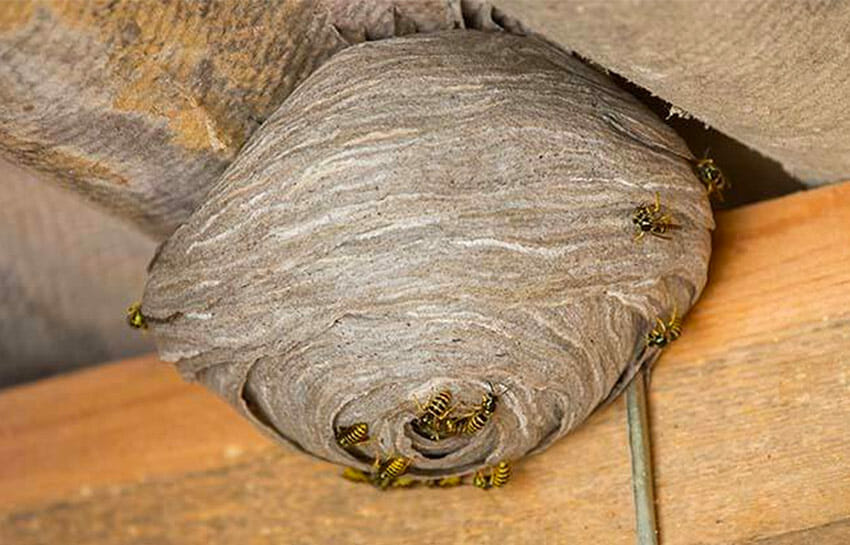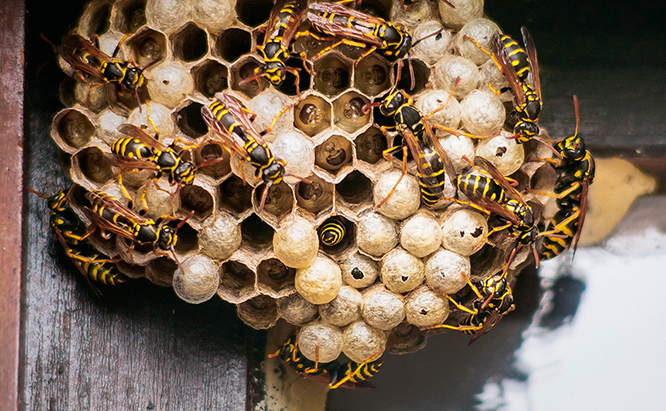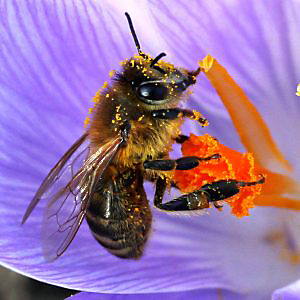HOW TO GET RID OF WASPS
The wasp family is very large and no matter the species, all types of wasps can possess a painful sting in addition to forming nests in inconvenient places that can lead to wasp stings. Getting rid of wasps is fairly simple, yet the process can potentially be dangerous without the proper products and equipment.
To get rid of wasps, make sure you select the proper kinds of products based where the wasp or nest is located. Wasp dusts can be safer to administer than spray insecticides as they can be applied from a safe distance. Always apply any product several feet away from a nest.
Wasp control can be achieved as a DIY project but it is usually better to contact us for professional wasp nest removal and control. If you do decide to tackle wasps on your own then it is important to know what steps to take to prevent potentially life-threatening injuries with these insects. Read on to discover more about wasps and where to find their nests as well as a range of products and procedures to effectively remove wasps from your living space.
Are Wasps Considered Pests?
Even though wasps will not typically invade your home or cause damage to your property, wasps are considered to be a pest based on the potential of causing injury due to the stings they inflict when disturbed. Wasps nests can also pop up under the eaves of porches and garage perimeters, which can be unsightly and cause concern for any guests you may have over during the warmer months.
Wasp Behaviours
Wasps are programmed to do three primary things: reproduce, build wasp nests, and seek out sugary food sources. It is important to understand those three aspects to gain a grasp of where you can expect to encounter wasps.

Wasps & Bees Control: How to Get Rid of Wasps and Bees
This page is a general wasps and bees control guide. Using the products and methods suggested you can get control of all wasp and bee species. The wasps and bees category pages give additional information on the different species. Follow these guides and use the recommended products and we guarantee 100% control of all bees or wasps species.
Wasps and bees can be an alarming presence around homes and businesses, but they can really become a problem when they have established a nest or hive upon a property. Many people are afraid of wasps and bees because they fear getting stung if they get too close.
There are many species of Bees and Wasps, and their characteristics can vary. The common characteristics between them are the fact that both are flying stinging insects, prone to aggression if provoked, and they are both pollinators.
Wasps and bees build their nests close to food and building resources. Paper wasps, for example, built their nest using wood fiber and need to be close to wooden structures. In many cases, these happen to be homes and businesses.
It’s important to know exactly which Wasp or Bee you are specifically dealing with before proceeding with a control program. There are many species of both wasps and bees, and their appearance can vary. It is easier to identify them by their nesting sites and their bodies.

The Best Wasp and Hornet Sprays
Taking out a wasp or hornet nest requires courage, precision, and speed—and a product that can do its job while keeping you as safe as possible. For that, you’ll need a can (or two, just to be sure) of a pyrethroid insecticide.
A key criterion for this product to be effective is a pyrethroid active ingredient, which is not unique to one brand. has two such agents, delivered in an extremely thick and robust foaming spray that quickly encapsulates a nest, trapping insects inside and reducing the chances of your getting stung. The foam is so thick that it hangs on vertical surfaces, nearly eliminating drips that can leave residue down the side of a house.
Terro sprays about 15 feet (when shot horizontally), which is right in line with the spraying distance of most competitors. This puts some decent space between you and the nest—and you’ll need it. The spray comes clean out of the can and is thick enough to withstand a slight breeze. It has a low odor, compared with that of some other cans.
One detail where Terro stood out was safety: This spray has a large cap that fits securely enough to deter a small child (for a moment), and it protects the nozzle if the can falls off a shelf.
If you’re in a pinch and you can’t locate Terro’s spray, we found two others that appear to be identical and should be just as effective. Among these three, it’s likely you’ll be able to find one on the shelves of a local store if you need one in an emergency.

Removing Wasp Nests
As the flowers and other natural food sources start to disappear, the move from the natural sugars and nectars from these food sources dry up and the need for proteins and carbohydrates increase. This is where the yellow jackets and the black and white wasps become more aggressive in finding alternative food sources
These alternatives include your soft drinks, meats, vegetables and any type of food that you may have been cooking in your backyard. Wasps do not have a barb on their stinger so when they come in to get a piece of your steak, if they are scared they will start stinging you many times and release a pheromone to make other wasps in the area come and sting you as well
We have many the counter products that can be used to treat wasp nests. Only use products that are registered for the control of wasps because using a pesticide to kill a pest that is not on label is against the law and you may be putting yourself and bystanders at risk of an improper application of insecticide. Using a liquid or foam spray will provide a direct and instant kill on contact.
The first thing you will need to do is find the nest. Wasp nests range in colour from light to dark grey and can range in size from a teacup, to a small baseball or even larger than a basketball. Some nests can be found in walls, cracks in walls, and even in the ground. Watch the nest during the day and find where the wasps are entering and exiting, the entrance hole will be near the bottom of the nest.
The best time to treat a wasp nest is either early in the morning or late evening when most wasps are inside and resting. If the nest is hidden, the entrances must be dusted with an appropriately label insecticide dust. This method takes several hours in order for the nest to be killed. The wasps will clean each other off, as they are social insects, and the dust kills the entire nest.
BEE? WASP? HORNET? A GUIDE TO STINGING INSECTS
Having a yard gives you an opportunity to get outdoors and enjoy the sunshine, fresh air and plants. That combination is also ideal for attracting a variety of insects and wildlife to your yard. When it comes to insects, the spring, summer and early autumn is an especially busy time.
Some of these insects can be benign or even helpful. Certain bugs – the dragonfly is a good example – help to control other insect populations. Butterflies are also beneficial insects – they serve as pollinators.
Other insects aren’t as completely harmless, though. Wasps, hornets and bees present an all-together different challenge for homeowners. While many of these insects offer similar benefits, they also pose a threat to people – they aggressively defend themselves by stinging other creatures they view as a threats.
STINGING INSECTS
“Bees!” — That’s the typical screeching reaction people have at the sight of a yellow-and-black flying insect. For the most part, however, bees aren’t what they should be worried about. Instead, it’s the wasps and hornets who give people the most trouble. Let’s take a look at the most common bee, wasp and hornet types present
AFRICANIZED BEE FACTS: These insects were created in 1957 after some imported African honey bees crossbred with those in South America. The result was a highly aggressive species that began expanding its range. As recently as 2011, these bees were found in the Northwestern U.S. A bit smaller than a typical honey bee, these bees tend to be easily provoked into defending their hive. As a result, they can attack in tremendous numbers and pursue their perceived threats farther than nearly every other insect on this list. Like their honey bee “parents,” Africanized bees die shortly after deploying their stinger. These bees are most common in the extreme southern U.S. It’s best to allow a professional to handle these insects.